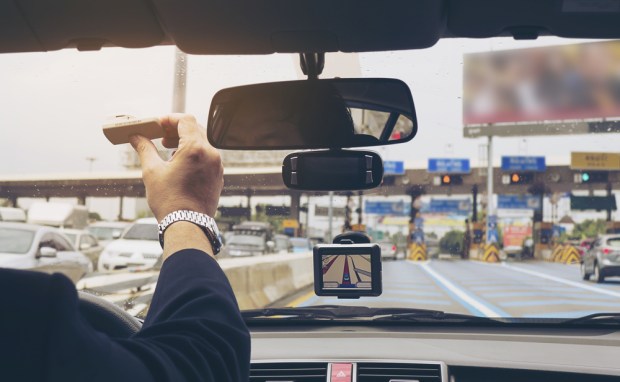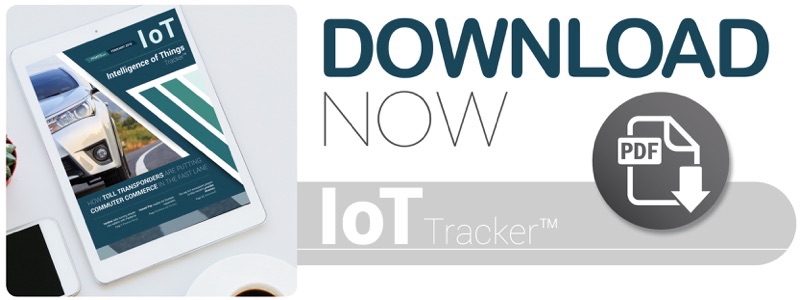How Toll Transponders Are Putting Commuter Commerce In The Fast Lane

The $212 billion that commuters spend on food, coffee, gas and parking during their commutes each year is a magnet for innovators to make those purchases even easier. Verdeva CEO Kevin Condon says that E-ZPass toll transponders might be the easy button that unlocks that in-vehicle payments opportunity, and can even provide the data to allow for new use cases like metered insurance premiums. Condon makes the case for why this network could drive in-vehicle payments into the fast lane.
Every workday, some 135 million Americans get behind the wheel for 15 to 30 minutes of commuting each way. In doing so, they reportedly drive $212 billion in annual commerce.
Nearly 54 percent of commuters place an order to pick up food along the way, 40 percent get their fix of morning joe and 39 percent find and pay for gas using their phones, according to The Digital Drive Report.
For the bulk of these commuters, the ability to pay for their purchases using connectivity built into their cars could change how they commute and shop. Two-thirds of respondents who use their smartphones to make purchases said they would do so more often if in-vehicle connectivity was available to them.
But, as it turns out, the ability to make in-vehicle purchases could be fulfilled by existing transponders already available to millions of motorists. These transponders are currently used to pay for tolls electronically, sparing motorists the ordeal of fishing to find change at a toll booth.
That’s an idea on which in-vehicle payment solution provider Verdeva is betting. The company recently partnered with E-ZPass Group, a provider of toll transponder technology, to explore how existing toll transponders could accelerate in-vehicle commerce. Earlier this month, the two companies announced the PayByCar pilot program, a collaborative effort that uses a network of electronic toll transponders to enable motorists to pay for a variety of vehicle-related items like gas and drive-thru orders, among others.
Verdeva CEO and founder Kevin Condon recently spoke with PYMNTS about the PayByCar program and how additional connectivity could change the way motorists manage their vehicle-related expenses. The technology could help motorists track and pay for inspections and oil changes, he said, and open the door to a new way of evaluating their driving habits and providing more accurate auto insurance rates.
Putting In-Vehicle Payments into Overdrive
In-vehicle payments are gaining popularity among major car industry players, and several automakers are already integrating them into their vehicle lineups’ designs. For example, General Motors is working with Mastercard to offer in-vehicle purchasing capability through its OnStar system. Meanwhile, Honda and Visa are working on a new payment subsystem allowing motorists to make payments at parking meters and gas pumps.
As Condon pointed out, the bulk of these efforts are still in their nascent stage, meaning it will be years before a large share of the public will have access to these features. By tapping into the existing reach of electronic toll transponders, though, Verdeva may have discovered a shortcut to putting in-vehicle payments on the road.
“In a nutshell, we’re trying to make in-vehicle payments a reality today, and easier for consumers to adopt,” Condon said.
Rather than build a new in-vehicle payment system from scratch, Verdeva is utilizing a network of transponder technology already in use in 35 million cars. That was the thinking behind the PayByCar program: to expedite the availability of in-vehicle payments by using existing hardware and networks.
“The fastest way [to deliver in-vehicle payments] is to leverage the installed base of over 60 million transponders in vehicles, which people already use for in-vehicle payment,” Condon explained.
Pilot Participants
Verdeva’s partnership with E-ZPass will allow customers to link their transponders to an account that is separate from the funds reserved for their toll transactions. Condon said the system is currently being tested at three gas station locations with on-site convenience stores, with plans to expand to 10 locations.
PayByCar is currently recruiting customers to participate in the pilot through direct marketing efforts. To participate, a customer on-boards by providing his E-ZPass transponder number, preferred payment information and smartphone number.
Once enrolled, the vehicle transponder detects that he is within proximity when he drives his vehicle to a participating retailer. As the car pulls up, the driver receives a notification on his smartphone asking if he would like to use PayByCar to complete a purchase. The smartphone can then be used to pay for gas at a pump or to authorize payments at the convenience store using the linked payment information.
Condon compared the service to Amazon Go, Amazon’s supermarket venture. The Seattle, Washington-based store allows customers to walk in, collect items and leave without physically paying, instead having their accounts immediately billed.
“[At Amazon Go stores], no payment transactions are occurring at a desk or checkout counter when you leave,” he said. “What we’re talking about is an in-vehicle version of that.”
Improving the Mobile Order-Ahead Experience
Condon is seeing additional opportunities to improve the mobile order-ahead experience for commuters as the PayByCar pilot continues. For example, he recently heard a complaint from a quick service restaurant (QSR) about the difficulty of timing food and coffee orders to be ready when the customer drives up.
“You could order when you’re three miles away, [and do so] by phone,” Condon said. “By the time you get to pick up your order, you could have hit a traffic jam or a longer line than you expected at the QSR. Now, your order has been filled by the restaurant, but it’s sitting there getting cold.”
Transponder technology could alert the QSR to when the customer is nearby, thus helping the business better time its preparation, Cordon said.
“The restaurant would know not to start filling [the order] until the customer pulls into the forecourt,” he explained.
Condon believes QSRs aren’t the only businesses that could benefit from transponder-based payments. He also sees an opportunity to further leverage the technology to centralize a variety of vehicle-related payments. For example, an oil change business posited that the tech could be used to accelerate how quickly motorists leave the business after stopping in for a service.
“A big part of their business model is speed[ing] people through,” Condon said. “It’s a value there.”
Smarter, More Connected Car Owners
Further down the road, Condon said the PayByCar technology could be used to help motorists consolidate and track a range of vehicle-related expenses. It could, perhaps, notify a motorist when her inspection sticker or registration is close to expiring, or when her vehicle is due for an oil change.
The connected tech could be used to gauge how much gas a vehicle has used, he added, and auto insurance companies could use the collected data to extend policies that more accurately reflect a motorist’s driving behavior.
“There’s a very real-world case of usage-based insurance,” he said. “We can offer usage-based insurance that’s more privacy-friendly than putting a dongle in an on-board diagnostics (OBD) port, and having an insurance company track where you are and how fast you’re accelerating.”
Overall, the goal of the PayByCar program is to explore additional ways that transponders and connected technology can benefit motorists beyond paying for tolls. With commuters already spending billions during their commuting time each year, the technology could turn millions of vehicles into millions of mobile wallets, offering motorists a glimpse into the future of seamless in-vehicle payments – not to mention to shift in-vehicle shopping into high gear.

